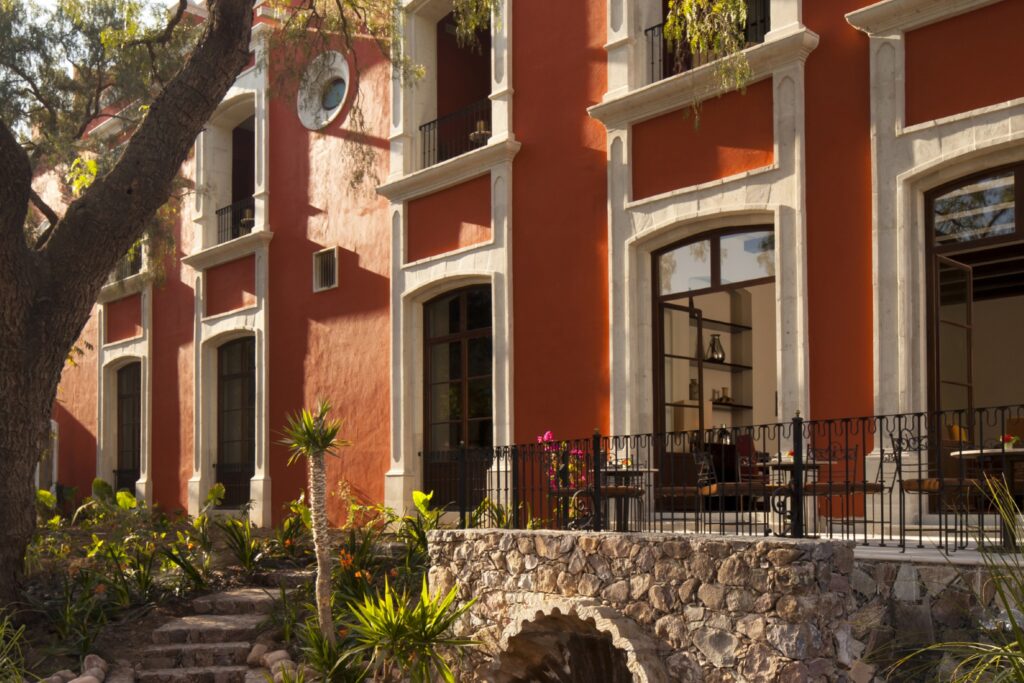By Emma Cutler Velez
May 15, 2024
Today a UNESCO World Heritage Site, the city was established in 1555 and adored by husband-and-wife Mexican artists Frida Kahlo and Diego Rivera, who spent a great deal of time here and encouraged their friends to join them.
Given its historical significance and architectural charm, it’s no surprise that great artists would gravitate toward the city. Perpetual spring weather — along with fresh mountain air and endlessly blooming bougainvillea — make San Miguel even more appealing. The cobblestone streets are meticulously maintained, down to pulling the tiniest weeds by hand. The facades of the historic center must adhere to the historical color palette of burnt sienna, yellows and reds. Doorways of businesses are adorned with colorful ribbons to differentiate them from homes, an age-old tradition in San Miguel.
Though I was prepared to be blown away by San Miguel, it far surpassed my expectations — largely due to my gorgeous accommodations. The Rosewood San Miguel de Allende, a colonial-style sanctuary in the heart of the picturesque Centro Histórico, is the perfect jumping-off point for exploring all that San Miguel has to offer. Reminiscent of a luxurious hacienda, with stuccoed arched doorways and flowing fountains, the Rosewood is nestled in expansive gardens with towering, perfectly manicured cedars and billowing pampas grass. Monarch butterflies flit from flower to flower as the smell of lavender and orange blossoms fills the air. With the hotel’s three gorgeous pools, tennis courts, open-air courtyards and panoramic city views, it is tempting to spend all day basking in the sun. At night, it’s easy to get cozy in the well-appointed suites, with wood-beamed ceilings, generous terraces, fireplaces and massive soaking tubs.
Each of the Rosewood’s four exceptional restaurants features delicious locally sourced ingredients, thanks to thoughtful partnerships with area farmers. The menus highlight regional influences, with elegant spins on classics like pozole verde and enchiladas. San Miguel is known for its rooftop culture, and the Rosewood’s Luna Rooftop is the best perch in town to grab dinner and take in 360-degree views, including the best view of the iconic 17th-century Parroquia de San Miguel Arcángel, an architectural gem.
After a day of exploring on foot, luxuriating in the Rosewood’s Sense spa was my favorite way to relax and reflect. It offers a creative blend of high-performance treatments, like HydraFacials, with introspective experiences, including a highly personalized birth chart consultation with the in-house expert. Many treatments incorporate indigenous botanicals and aromas, sourced from the nearby highlands, that are known for their healing properties, as well as quartz crystals, known for their influence on energy.
San Miguel is a hub for extraordinary art, crafts, furnishings and textiles. Emerging artists, designers and artisans from all over Mexico and the world flock here to work and collaborate while living a slower-paced existence steeped in cultural diversity. The acclaimed San Francisco design duo Jeffry Weisman and Andrew Fisher, now San Miguel transplants, consider the Mexican city their inspiration and a rich source of craftspeople for fabricating their home furnishings, sold at Casa Acanto. Hat designer Alejandra “Suki” Armendariz left her Sonora home to settle in San Miguel, where she creates the stylish sombreros offered at Suki Palomina.
Whether you’re looking for ceramic pineapples from Michoacán, handcrafted Oaxacan pottery or beautifully embroidered textiles woven by the best weavers from every region of Mexico, it’s all found in abundance in San Miguel. You may end up buying an extra suitcase just to bring your many treasures home; or better yet, ship back your haul — it’s all that good. Fabrica La Aurora, a favorite stop for art and design, is a former textile factory that now houses furniture, sculpture, paintings, crafts, textiles and fine art, as well as beautiful housewares from La Bottega di Casa. While strolling through the various open art studios, you can witness the creative process firsthand.
Elsewhere, antiques, boutiques, galleries and design showrooms abound. The Galería Casa Diana is another absolute must for art lovers. Filled with eye candy, it is the former home of Pedro Friedeberg, one of the preeminent Mexican artists working today, famous for his signature Hand Chair. The surrealist’s work surrounds you in this beautiful space, which includes the world’s largest collection of his intricate paintings. Snakes in relief slither up a wall of the courtyard, and a majestic lion’s mouth serves as a fireplace.
Meanwhile, La Casa Dragones might just be the most beautiful setting in which I’ve ever sipped tequila — in this case, the Casa Dragones brand, which credits San Miguel, with its rich heritage, as its spiritual home. The tasting room is incredibly intimate, offering only six seats. The artful juxtaposition of contemporary decor and 17th-century architecture creates an enchanting ambiance. And four thousand obsidian tiles provide an incredible backdrop to the bar in a nod to the rich volcanic soil of the Jalisco lowlands, where the brand’s agave is grown. La Casa also features a small number of guest rooms, which aren’t available to stay in but, rather, serve as a showcase of impeccable interior design. La Casa was created in collaboration with New York design boutique Meyer Davis, with contributions from Mexican talents including Ana Elena Mallet and Raul Cabra; for their work, the team received the 2024 Créateurs Design Award for Best Hospitality Project in Interior Design. So even if su no bebe, you can still drink in the breathtaking opulence.


